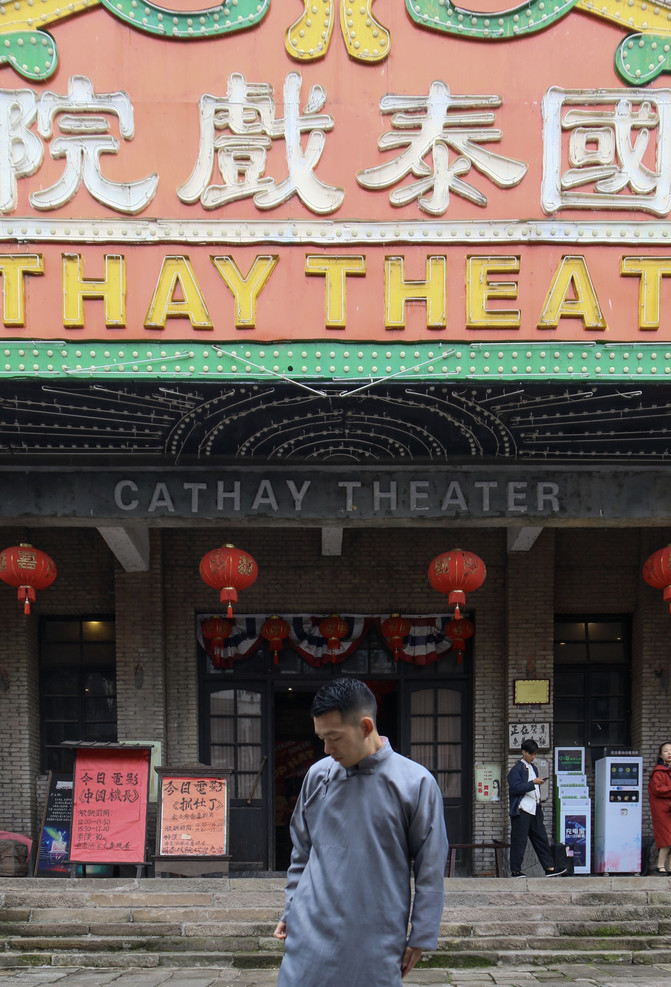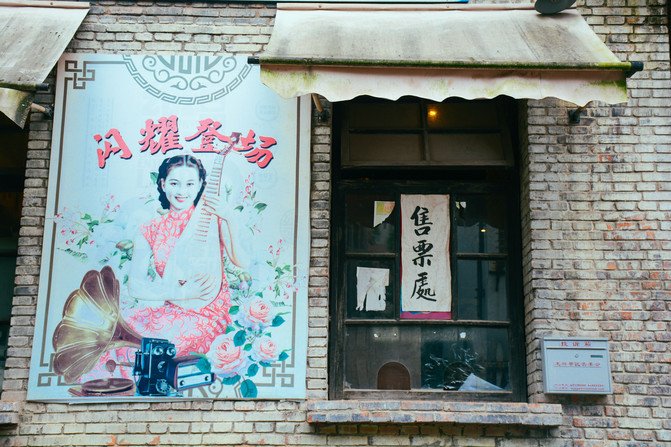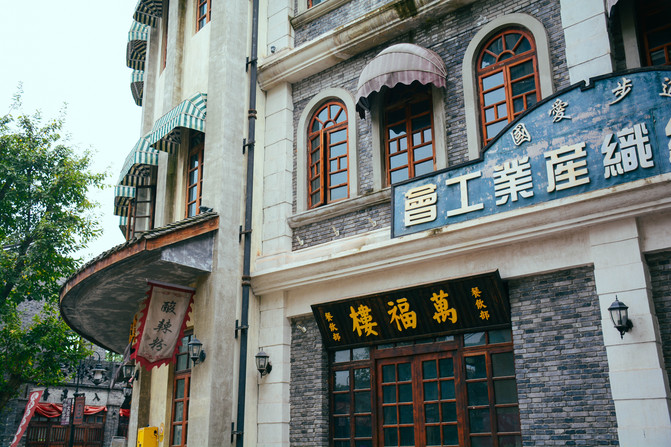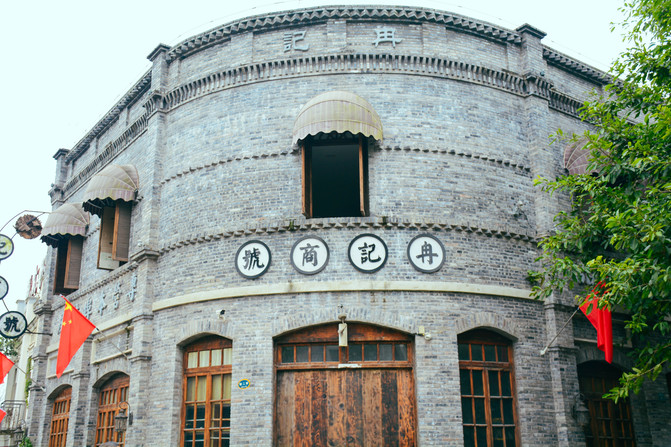8 hours in Chongqing | Take you to explore Chongqing in the movie
I don't remember how many times I've been to Chongqing, nor how many times I've seen Chongqing in movies. Every time I come to Chongqing, I feel like I'm making a movie. Chongqing has never lacked the support of movies, from "Crazy Stone" to "Passing Through Your World" and "Hot Pot Hero", to this year's film "Young You" that focuses on campus bullying. However, most of these movies were shot in the urban area of Chongqing, and every scene in the movies may have been changed due to the storyline, but there is one place that has not changed, which is the "Two Rivers Film and Television City". It is only an hour's drive away from the urban area of Chongqing, but here you will see a different Chongqing figure.
The "Liangjiang Film and Television City" is an important project for the development of Chongqing's emerging cultural industry in the Liangjiang New Area of Chongqing. The planned total construction area is about 350000 square meters, creatively restoring the architecture of the Republic of China and Bayu, infusing the charm of mountains and waters, inheriting historical culture, following folk customs, and restoring the era style of China's central city and international metropolis during the period of Chongqing's capital. Give me 8 hours this time, and I will take you to visit a different Liangjiang Film and Television City.

As soon as we approach Liangjiang Film and Television City, the first thing we see is the "Memorial Monument of Meritorious Achievements in the Victory of the Anti Japanese War". Its prototype is the Memorial Monument of Meritorious Achievements in the Victory of the Anti Japanese War in Chongqing (today's People's Liberation Monument), which was built in 1946. The original site is located at the intersection of Minquan Road, Minquan Road and Zourong Road in Yuzhong District. Because of its unique historical connotation, it is included in the construction sequence of the old buildings of Liangjiang Film and Television City. In fact, when I see this Monument to the people's Liberation, I feel as if I am.

The prototype of Guotai Theater was the Anti Japanese War Guotai Grand Theater, located at the entrance of Chaijia Lane in Yuzhong District (now Zourong Road). Due to its special historical significance, it was included in the sequence of old buildings in Liangjiang Film and Television City.


The Guotai Theater screens different movies at different times every day, most of which are old movies from the past and have a unique flavor. Of course, occasionally there are also popular movies from the current era that can be seen here.

The theater now has exciting magic performances every day during the day, and at night, it provides free movie screenings for the public.

The phonograph in the theater, as well as the posters on the walls, instantly felt like they were transported back to the era of the Republic of China, where movies were heavy.

When it comes to Xinhua Daily, everyone is familiar with it, but did you know that the previous Xinhua Daily moved from Wuhan to Chongqing?

On January 11, 1938, Xinhua Daily was officially founded in Wuhan. On October 25, after the fall of Wuhan, the newspaper moved to Chongqing. Afterwards, this place became an important place for the Xinhua Daily News Agency to handle subscription and distribution business, and to sell revolutionary and progressive books; This business department is modeled after the prototype, with a partial restoration of the internal scene.

In the newspaper, you can also see exclusive memories of that era.

The prototype of Hengdali Watch Store is the Shanghai Hengdali Watch Store, located at the Nanjing Road Throwing Stadium (now the intersection of Nanjing East Road and Henan Road) in Shanghai. Due to the need to include the setting of the movie "1942" in the construction sequence of the old buildings of Liangjiang Film and Television City, it was reconstructed in a 1:0.8 ratio in June 2016.

At that time, it was because of the location of the movie "1942" that the two film and television cities continued to expand and build many places on the original basis. It is a comprehensive tourist attraction that integrates film and television shooting, cultural tourism, vacation and leisure, and historical sightseeing.
Speaking of which, there are actually a lot of content that can be filmed in Liangjiang Film and Television City. You can actually find a store like me, rent a piece of clothing, and fully immerse yourself in this scene, experiencing a different Chongqing flavor.

The clothes here are also very cheap, costing 30 yuan each. There are many options to choose from according to your own preferences, and you can take a few photos. In addition to taking photos of Zhao, you can also explore every place in the film and television city. It's really great.


Walking inside the film and television city, I feel like every scene is a movie scene, and every scene is recorded for a long time.

The retro style small Western style buildings in the film and television city showcase the most aesthetic architectural aesthetics of Chongqing at that time, and the second and third floors will gradually open, welcoming more merchants to settle in.

The prototype of Qunlin Market is Chongqing Qunlin Market, located at 226 Minzu Road, Yuzhong District. Due to its commercial landmark connotation, it was included in the construction sequence of the old buildings of Liangjiang Film and Television City and was rebuilt in June 2016 at a ratio of 1:0.6.










Of course, in addition to these various retro buildings, you can also see the large-scale street scene experience drama "The Sichuan Army Goes Out of the River" recently launched by Liangjiang Film and Television City on site, which takes about half an hour to perform.

The experiential drama "The Sichuan Army Goes Out of Sichuan" is set against the backdrop of the War of Resistance Against Japan, integrating numerous historical documents from both "big history" and "small markets". It presents the story of the brave struggle of the people of Bashu to defend their motherland, demonstrating the patriotic spirit of the anti Japanese heroes who believe that "the rise and fall of the country is the responsibility of every man".

Interactive experience is a major highlight of "Sichuan Army Goes Out of the River". The design inspiration for the interactive segment comes from independent programs that have been popular among tourists since the opening of the Liangjiang International Film and Television City scenic area, such as "Grand Parade" and "Street Stunt". The clever integration of interactive elements into the plot of 'Chuanjun Chuchuan' not only ensures the participation of tourists, but also respects the laws of history and performance.

Here, everyone can follow this non interactive experience drama, watch the performance, and experience the story of the brave struggle and defense of the motherland by the people of Bashu at that time.

Of course, if you're lucky, you can also see movies and TV shows being filmed here. When I went there that day, I didn't know which crew it was. After asking the staff, I found out that it was the crew who woke up and filmed here that day. They are three film and television dramas, namely "Hello Yesterday", "For the New China", and "Ultimate Battle".




After saying so much, do you also want to come and see Liangjiang Film and Television City? Here I also provide you with a tour route, of course, these can be customized according to your actual situation.
Suggested tour route:
Tourist Center Ticket Purchase → Yulin Trading Dress Up → Merit Monument → Chaotian Gate → Church → Wuwen Academy → Lunch → Xiangfu Teahouse → Xinhua Daily News → Presidential Palace Visit → End
In the film and television city, you can admire the unique architecture of the mountain city, taste authentic martial arts cuisine, and experience the different culture of Chongqing Film and Television City.



Traffic routes
Take public transportation to the film and television city route
Suggested route from Yubei District to Film and Television City: Take Light Rail Line 3 → Dabijin Station → Take Route 555 (or take Route 865, 684, 691 to cross over, Route 608, 622, 609, 655, 691, 681) → Arrive at Green Dream Square Station → Take Route 980 → Arrive at Liangjiang International Film and Television City Station.
Suggested route from Jiangbei District to the Film and Television City: There is a direct shuttle bus to Longxing at Hongqihegou Bus North Station → take bus 980 → Liangjiang International Film and Television City Station.
Suggested route for self driving to the film and television city:
Jiangbei, Yuzhong, and Nan'an directions: You can reach the scenic area by passing through the Inner Ring Road → G50S Jiangbei Toll Station → G5001 Ring Expressway → getting off at Longxing Toll Station → Liangjiang Avenue →; Or take the Airport Expressway → Shengxing Avenue on Baosheng Interchange → Huanshan Tunnel and Tongluoshan Tunnel → Modern Avenue → Liangjiang Avenue → arrive at the scenic area.
Beibei direction: You can take G5001 Ring Expressway via Beibei South Toll Station, get off at Longxing Toll Station, take Liangjiang Avenue, and reach the scenic area; Alternatively, take the G75 Lanhai Expressway towards the North Ring Road, then take the Caijiagang Interchange onto the Central Expressway, then Jinxing Avenue, Jiayue Bridge, Baosheng Interchange onto Shengxing Avenue, pass through the Huanshan Tunnel and Tongluoshan Tunnel, then Modern Avenue, Liangjiang Avenue, and finally reach the scenic area.
In the direction of Yubei Road, you can take G5001 Ring Expressway at the airport toll station, get off at Longxing toll station, take Liangjiang Avenue, and reach the scenic area; Or take the airport expressway → Shengxing Avenue on Baosheng Interchange → pass through the Huanshan Tunnel and Tongluoshan Tunnel → Modern Avenue → Liangjiang Avenue → arrive at the scenic area.





I hope that friends who travel to Chongqing in the future can come here more and experience the different Chongqing Liangjiang Film and Television City, and become the protagonist of a movie here.
Previous Article:These buildings at the intersection of the two roads have left traces in modern Chinese history
